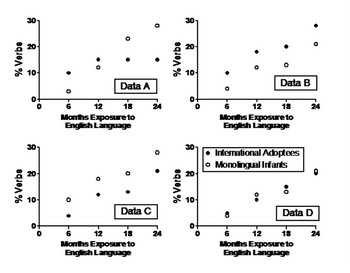q0A% % Verbe 30 20- 10- 30 20 10- 0 0 0 Data A 6 12 18 Months Exposure to English Language Data C 6 12 18 Months Exposure to English Language 0 24 24 % Verbe % Verbe 20- 10- 30 20- 10- 0 ♦ 0 6 12 18 Months Exposure to English Language 8 Data B ◆ International Adoptees Monolingual Infants 0+ 0* 24 Data D 6 12 18 Months Exposure to English Language 0 24
Oh no! Our experts couldn't answer your question.
Don't worry! We won't leave you hanging. Plus, we're giving you back one question for the inconvenience.
Question: (Scenario 9.1) Snedeker and colleagues (2007) studied the acquisition of English as a second language in preschool children adopted from China. In trying to disentangle the role of linguistic and cognitive development on language acquisition, which factor would serve as the MOST appropriate control group?
Scenario 9.1 is based on and presents results consistent with the following studies:
Snedeker, J., Geren, J., & Shafto, C. L. (2012). Disentangling the effects of cognitive development and linguistic expertise: A longitudinal study of the acquisition of English in internationally-adopted children. Cognitive Psychology, 65(1), 39–76. doi:10.1016/j.cogpsych.2012.01.004
Snedeker, J., Geren, J., & Shafto, C. L. (2007). Starting over: International adoption as a natural experiment in language development. Psychological Science, 18(1), 79–87. doi:10.1111/j.1467-9280.2007.01852.x
Language development occurs in orderly stages, beginning with one-word utterances and progressing to two-word utterances, simple sentences containing function morphemes, and the emergence of grammatical rules. Psycholinguists have attempted to determine if language development is a consequence of cognitive development or if it reflects linguistic processes that occur independently of general cognitive development. Studies on the acquisition of a second language in internationally adopted children have provided insight into this research question. In a series of studies, Snedeker and colleagues (2007, 2012) studied the acquisition of the English language in adopted preschoolers from China. These children had no exposure to the English language before being adopted by families in the United States.










